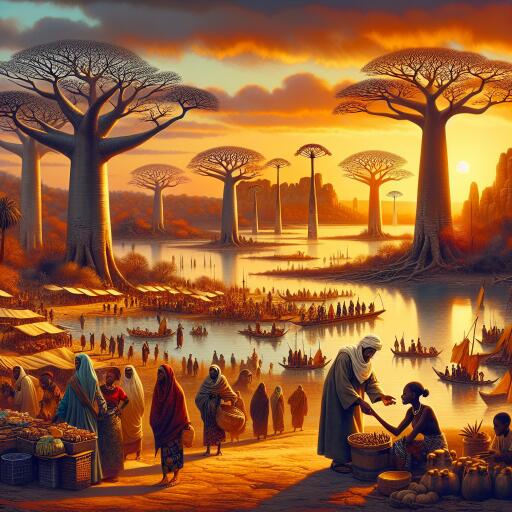
What are some hidden gems in the Sahel region?
The Sahel region, a semi-arid belt stretching across Africa from the Atlantic Ocean to the Red Sea, often finds itself associated with stories of conflict and environmental challenges. Yet, beneath these headlines, lies a landscape rich with cultural treasures, natural wonders, and incredible resilience. The Sahel region, an intersection of diverse cultures and breathtaking landscapes, offers a unique perspective on both West and North Africa.
This transition zone isn’t just a geographical area; it’s a tapestry woven with various traditions and histories, resonating through ancient ruins and lively marketplaces. From majestic sandstone towers to thriving river cities and vibrant nomadic customs, there’s much to uncover in this often-overlooked region.
Despite the unforgiving landscapes, biodiversity flourishes in unexpected pockets. Take Sudan’s Sacred Forest of Kassala, a lush sanctuary bustling with birdlife and ancient trees, exemplifying vital conservation efforts. The Ennedi Plateau in Chad, recognized as a UNESCO World Heritage site, boasts captivating sandstone arches and canyons, in addition to ancient rock art that echoes the region’s history. Further west, Mauritania’s Banc d’Arguin National Park serves as an essential breeding ground for migratory birds and houses a stunning coastal ecosystem—just glimpses of the natural wonders waiting to be explored.
The Sahel serves as a cultural crossroads, shaped by nomadic traditions, Islamic scholarship, and ancient empires. In Mali’s Timbuktu, once a beacon of learning and commerce, visitors can explore the Djinguereber Mosque, a remarkable mud-brick structure with a story to tell. The Dogon people in Mali, known for their elaborate masks and unique cliff dwellings, offer a glimpse into intricate textile traditions. Meanwhile, the Fulani people share their dynamic music and storytelling practices, bridging communities across this vast region.
As the Sahel confronts climate change and conflict, its communities showcase incredible resilience. The local farmer’s adaptation techniques to arid conditions, using traditional irrigation, demonstrate ingenuity. Numerous local organizations endeavor to combat desertification and endorse sustainable development, highlighting the resourcefulness of the Sahel’s inhabitants—a hidden gem in itself, embodying hope for the future.
Travel Tips and Insights
**When to Visit:** Experience the Sahel during its cooler months from November to February, when temperatures are milder, and the likelihood of rain diminishes. Nevertheless, the climate remains tough, even in the cooler periods.
**Safety Considerations:** Some areas in the Sahel pose high risks due to political instability and armed groups. Thoroughly research regions before visiting, heed travel advisories, and consider enlisting experienced local guides or reputable tour operators.
**Visa Essentials:** Visa requirements fluctuate depending on your origin and the specific Sahel nation you visit. Secure the necessary visas well ahead of your trip and stay updated on passport requirements by contacting the respective embassies or consulates.
**Cultural Etiquette:** To show respect for local customs, dress modestly, particularly at religious sites, ask permission before photographing people, and be aware of Ramadan fasting periods. Simple phrases in the local language can create rapport, and small gifts are often welcomed warmly.
**Language Diversity:** While Arabic and French prevail in urban centers, indigenous languages like Hausa, Fulfulde, Wolof, and Bambara are prevalent. Learning basic phrases in these languages enhances your journey.
**Accommodation Options:** Ranging from basic guesthouses and hotels in urban centers to rustic lodgings in rural locales, luxury hotels are uncommon outside capital cities. Choose accommodations aligning with your comfort level and budget, keeping in mind that camping might be the only option in certain areas.
**Packing Must-Haves:** Prepare with lightweight, breathable clothing, a wide-brimmed hat, sunglasses, sunscreen, insect repellent, a first-aid kit, and essential medications. Walking shoes are vital, as well as readiness for hot days and cool evenings. Bringing a portable water filter or purification tablets is wise.
**Culinary Experience:** Sahelian cuisine includes staples such as millet, sorghum, rice, and meats like goat and lamb, often enriched with spices, resulting in hearty meals suitable for the climate. Exercise caution with raw fruits, vegetables, and water—ensure it’s purified.
**Currency Dynamics:** The currency varies across countries, with many West African nations using the West African CFA franc (XOF), while others, like Mauritania, have distinct currencies. Research before your visit and adjust money accordingly, as credit cards are not commonly accepted outside major cities.
Fostering Sustainable Tourism
Sustainable tourism initiatives in the Sahel center around community-based tourism, ecotourism, and cultural preservation. Supporting locally owned guides, staying at resident-managed guesthouses, and purchasing handicrafts directly from artisans can aid in fostering economic wellbeing and responsible travel practices. Ecotourism efforts to safeguard wildlife and habitats are also progressing.
Several ways exist to support local communities during your visit. Opt for local businesses wherever possible, purchase handicrafts directly, volunteer with organizations on development projects, and honor local customs and traditions. Your thoughtful spending and respectful interactions contribute to community empowerment and sustainable development.
The Sahel hosts a myriad of cultural festivals and events, though some, like Mali’s Festival au Désert, have been suspended due to security issues. Islamic celebrations such as Tabaski (Eid al-Adha) and Korité (Eid al-Fitr) remain significant throughout the region. Delve into local calendars to uncover smaller, regional festivals offering unique insights into Sahel traditions and customs, fostering connections with local communities, and experiencing their rich cultural legacy.
Exploring the Sahel provides an enriching journey, promising profound discoveries and appreciation for the resilience and beauty within this exceptional region.





Leave a Reply